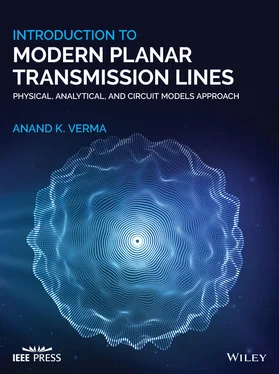1.3.2 Key Features, Intended Audience, and Some Suggestions
Key Features
Possibly, it is the first comprehensive book dedicated entirely to the planar transmission lines. The book covers the microstrip lines, CPW, and other classical resonating structures from basic to advanced form in one cover. The book further covers the EBG and metamaterial‐based planar transmission lines and surfaces. These are the topics of current interest. The sequence of the chapter is logical and of increasing complexity.
The emphasis of the book is on the modeling of the planar lines and engineered surfaces using the physical concepts, circuit‐models, closed‐form expressions, and the derivation of a large number of expressions. It provides an in‐depth review of the classical transmission line theory, electromagnetics, modeling of the material medium, and waveguide structures compactly without sacrificing the clarity of presentation.
The advanced mathematical treatment of the topics, such as the variational method, conformal mapping method, and SDA for several kinds of planar line structures is carried out in detail to help the new readers unfamiliar with these topics. A large number of illustrative examples from the published literature are given to clarify the theory and physical principles involved in the contemporary topics of the EBG lines and surfaces, metamaterials, metalines, and metasurfaces.
The multilayer structures useful for the MMIC, MEMS, and LTCC technology are covered. The closed‐form modeling of dispersion, frequency‐dependent characteristic impedance, and losses in the multilayer planar transmission lines is covered for the first time in a book‐form. Also, the basic fabrication technology of the planar transmission lines in the MMIC, MEMS, and LTCC technology is described to help the modelers of the EM‐phenomenon and microwave circuit designers.
Thus, the book prepares the reader to follow the modern designs of the planar circuits and also to undertake independent researches in the field of planar microwave technology.
The book is intended to help undergraduate students of third/fourth year and also postgraduate students. It is useful to the teachers of microwave engineering in preparing lectures, assignments, and projects. The new researchers in the field of microwave engineering will find the book useful to improve their skills in the modeling of the planar structures. It is also suitable for the self‐study of the RF/Microwave professionals in the industries. The selected chapters could be used in classroom teaching. It could be the main text for conducting elective courses at the university level. Further, the book can serve as a reference book even to more experienced users in the industry.
The students and new researchers can have a fast review of the transmission line theory, EM‐theory, and so on from chapters 2– 7. Then it will be much easier to follow the remaining text. It will be also helpful in following other advanced books and published current literature. However, experienced readers can read any chapter or topic. The concept for the forward and backward referencing of chapters, sections, and subsections are provided to help the reader to skip the chapters or to go back to an intended topic inside the book.
A large number of closed‐form expressions are given for the modeling purpose. A reader is encouraged to write the Matlab codes or codes in any other language familiar to him/her. The teacher can assign to students the code development as homework. Such activities will enhance the learning process and skill development. More efforts will be needed to write the codes for the variational method, Galerkin's method, and the SDA. Of course, the effort is rewarding.
The researchers must look into the journals to follow newer investigations and decide the direction of his/her research activities. Good luck!
1 B.1 Nahin Paul, J.: Oliver Heaviside, Sage in Solitude: The Life, Work, and Times of an Electrical Genius of the Victorian Age, IEEE Press, New York, 1988.
2 B.2 Mahon, B.: Oliver Heaviside: Maverick Mastermind of Electricity, IET, London, 2009.
3 B.3 Yavetz, I.: From Obscurity to Enigma: The Works of Oliver Heaviside 1872–1889, Birkhäuser, Basel, Switzerland, 2011.
4 B.4 Whittaker, E.: A History of Theories of Aether and Electricity (Two Volumes), Dover Publications, Dallas, TX, USA, 1989.
5 B.5 Sarkar, T.K.; Mailloux, R.J.; Oliner, A.A.; Salazar‐Palma, M.; Sengupta, D.L.: History of Wireless, John Wiley & Sons, Inc., Hoboken, New Jersey, USA, 2006.
6 B.6 Elliott, R.S.: Electromagnetics: History, Theory, and Applications, IEEE Press, Piscataway, NJ, 1993.
7 B.7 Lorentz, H.A.: The Theory of Electrons and Its Applications to the Phenomena of Light and Radiant Heat, 2nd Edition, B.G. Teubner, Leipzig, 1916.
8 B.8 Stratton, J.A.: Electromagnetic Theory, McGraw‐Hill, New York, 1941.
9 B.9 Collin, R.E.: Field Theory of Guided Waves, 2nd Edition, IEEE Press, New York, 1991.
10 B.10 Harrington, R.F.: Time‐Harmonic Electromagnetic Fields, McGraw‐Hill, New York, 1961.
11 B.11 Feynman, R.P.; Leighton, R.B.; Sands, M.: The Feynman Lectures on Physic, Vol. II, Electromagnetic Field, pp. 15‐8, 15‐14, Addison – Wesley Pub. Co. Inc., Boston, Indian Reprint, B.I. Publications, New Delhi, 1969.
12 B.12 Thomson, J.J.: Recent Researches in Electricity and Magnetism, Clarendon Press, Oxford, 1893.
13 B.13 Fricke, H.M.: Two rival programme in 19th‐century classical electrodynamics action – at‐ distance versus field theory, Ph. D. Thesis, London School of Economics & Political Science, 1982, London.
14 B.14 Fache, N.; Olyslager, F.; Zutter, D.D.: Electromagnetic and Circuit Modeling of Multiconductor Transmission Lines, Clarendon Press, Oxford, 1993.
15 B.15 Brillouin, L.: Wave Propagation in Periodic Structures ‐ Electric Filters and Crystal Lattice, 2nd Edition, Dover Publications, New York, 1953.
16 B.16 Itoh, T. (Editor): Planar Transmission Lines, IEEE Press, Piscataway, NJ, 1987.
17 B.17 Khine, M.S.; Saleh, I.M. (Editors): Models and Modeling in Science Education, Vol. 6, Springer Dordrecht Heidelberg, London, New York, 2011.
1 J.1 Elliott, R.S.: The history of electromagnetics as Hertz would have known it, IEEE Antennas Propag. Soc. Newsl., Vol. 30, No. 3, pp. 5–18, June 1988
2 J.2 Grattan‐Guinness, I.: Why did George Green write his essay of 1828 on electricity and magnetism?, Am. Math.Mon., Vol. 102, No. 5, pp. 387–397, DOI: 10.1080/00029890.1995.12004591 http://about.jstor.org/terms.
3 J.3 Wu, A.C.T.; Yang, C.N.: Evolution of the concept of the vector potential in the description of potential interactions, Int. J. Mod. Phys. A, Vol. 21, No. 16, pp. 3235–3277, 2006.
4 J.4 Eliseo Fernández, E.: Concepts and instruments: the potential from Green to Kelvin, The Midwest Junto for the History of Science, March 25–27, 1994.
5 J.5 Challis, L.; Sheard, F.: The green of Green’s function, Phys. Today, Vol. 56, No. 12, pp. 41–46, 2003.
6 J.6 John Roche, R.: The present status of Maxwell’s displacement current, Eur. J. Phys., Vol. 19, pp. 155–16n, 1998.
7 J.7 French, A.P.; Tessman, J.R.: Displacement currents and magnetic fields, Am. J. Phys., Vol. 31, pp. 201–204, 1963.
8 J.8 Scheler, G.; Paulus, G.G.: Measurement of Maxwell’s displacement current, Eur. J. Phys., Vol. 36, No. 055048, pp. 1–9, 2015.
9 J.9 Selvan, K.T.: Presentation of Maxwell's equations in historical perspective and the likely desirable outcomes, IEEE Antennas Propag. Mag., Vol. 49, No. 5, pp. 155–160, Oct. 2007.
Читать дальше












